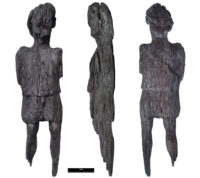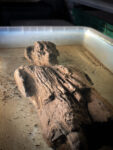 The archaeological program surveying the site of the HS2 high speed rail construction have unearthed another rare artifact: an early Roman carved wooden figure. It was discovered in July 2021 at Three Bridge Mill in Twyford, Buckinghamshire. It was in a water-logged ditch from the early Roman era, preserved from decomposition by the anaerobic clay fill of the ditch.
The archaeological program surveying the site of the HS2 high speed rail construction have unearthed another rare artifact: an early Roman carved wooden figure. It was discovered in July 2021 at Three Bridge Mill in Twyford, Buckinghamshire. It was in a water-logged ditch from the early Roman era, preserved from decomposition by the anaerobic clay fill of the ditch.
When it first emerged from the excavation trench, archaeologists thought it was just a random piece of wood. As they painstakingly removed the soil, they realized it was a carved anthropomorphic figurine. It was carved from a single piece of wood as is more than 26 inches high (67 cm) and seven inches wide. Today the arms below the elbows and the feet have decayed, but much of the carved detail survives on the head, the tunic that gathers at the waist and the shaped calves.
The style of carving and the figure’s tunic-like garment suggested it was made in the early Roman period. Shards of pottery from the ditch confirmed that assessment when they were radiocarbon dated to between 43 and 70 A.D.
The occurrence of carved, wooden, figures in British prehistory and the Romano-British period is extremely rare. In 2019 a wooden limb, thought to be a Roman votive offering, was found at the bottom of a well in Northampton. Examples of full Roman carved figures have been recovered in Dijon and Chamalières in France. A wooden carving, the ‘Dagenham Idol’, was recovered from the north bank of the Thames is 1922 and has been dated back to the Neolithic period and an early Iron Age carved figure was recovered from the banks of the River Teign, Kingsteignton in 1866.
Jim Williams, Senior Science Advisor for Historic England, said:
“This is a truly remarkable find which brings us face to face with our past. The quality of the carving is exquisite and the figure is all the more exciting because organic objects from this period rarely survive. This discovery helps us to imagine what other wooden, plant or animal-based art and sculpture may have been created at this time. Further analysis has the potential to reveal more detail, perhaps even providing clues about where it was made.”
 The figurine is now being examined and conserved in York Archaeology’s conservation laboratory. A small fragment of the figurine that was found broken off next to it will be radiocarbon dated and subjected to stable isotope analysis to determine, if possible, its place of origin.
The figurine is now being examined and conserved in York Archaeology’s conservation laboratory. A small fragment of the figurine that was found broken off next to it will be radiocarbon dated and subjected to stable isotope analysis to determine, if possible, its place of origin.